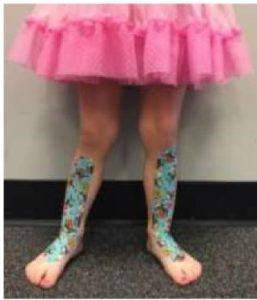Why would we use Kinesiotape on children and how does it help them?
There are many different tapping methods available in the clinic and many reasons why we would try taping. See below for specific ways tape can be helpful and when we would not use tape. For children, tapping is most helpful with improving function and promoting postural control to help facilitate gross motor, fine motor, or oral motor skills.
Kinesiotaping can help with:
– Improve muscle function
– Improve sensory awareness
– Support ligaments and tendons
– Improve lymph/blood circulation
– increase range of motion
– Decrease edema/swelling
– minimize pain
– limit muscle fatigue
– delay onset of muscle soreness
– decrease scars/adhesions
– assist with organ dysfunction
– prevent injuries
– reposition joints
– improve postural alignment
– improve gross/fine/oral motor skills
– improve balance
– improve walking patterns
– facilitate breathing
It would not be appropriate to use Kinesiology taping with children that have the following:
– open wounds/cuts/scrapes/rashes on the areas that tape would be applied
– non-healed scars
– thin/fragile skin
– infected area
– kidney Problems
– a known allergy to adhesives/acrylic/silicone
– Congestive heart failure
– Deep Vein Thrombosis (DVT) or blood clot
Precautions would need to be taken with the following:
– Previous reactions to tape/adhesive
– Decreased sensation
– GI issues such as severe reflux
– Infant in NICU
– Rash/eczema
– Pica disorder
– Suspected DVT
– Taking anti – coagulant
– Diabetes, venous insufficiency peripheral neuropathy
As a pediatric physical therapist, I like to use taping to facilitate function. For example, I use tape to assist with heel strike with my kids that like to walk on their toes. This has been very successful with my sensory seeking toe walkers, especially because not only does it assist with muscle activation in the front of the foot it also provides sensory feedback to the brain. I also use it to assist with babies that have torticollis to assist with symmetrical posture and strengthening the weak side. It is very common for a baby with torticollis to favor a side throughout development due to one side of the body being weaker than the other. Tapping gives feedback to the baby to use their weaker side more appropriately. Taping can also be very helpful to prevent knee hyperextension with children that are hypermobile and like to lock their joints out. When children lock their joints out, they are not activating their muscles surrounding that joint appropriately and therefore not gaining strength. Taping can assist with placing the body in a more functional position so the child gains strength appropriately.
If you feel taping could help your child please feel free to speak to a physical therapist by contacting us at (513)-755-6600 or by https://www.abcpediatrictherapy.com/contact-us/
 Skip to content
Skip to content